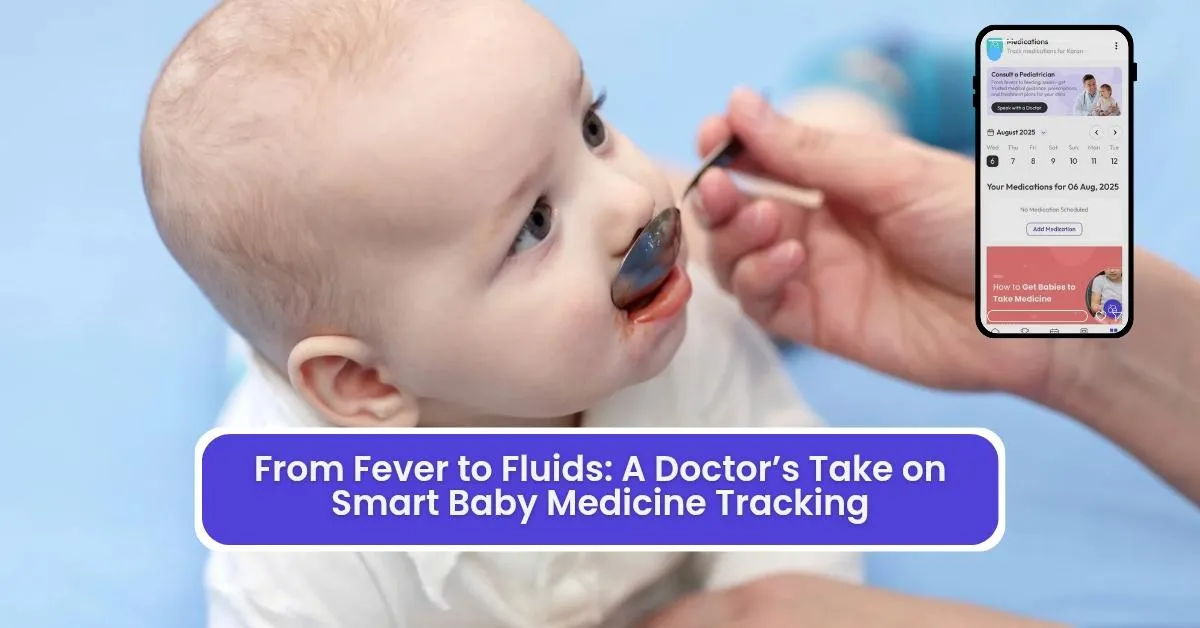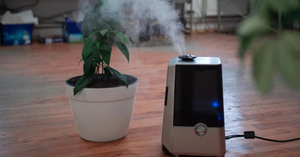You know your baby best.
So when your usually cheerful child suddenly becomes dull, warm to touch, and unusually clingy, you sense something’s not right. That’s when most parents think: Is it a fever? Should I give paracetamol? When do I need to worry? In the middle of panic, tracking symptoms and medicines might feel like too much, but it’s one of the smartest tools you can use during illness.
What Is Fever? (Medical vs Layman Meaning)
Medically, fever means a rise in body temperature above normal, usually due to infection. The standard definitions are:
- Rectal temperature ≥ 100.4°F (38°C)
- Oral temperature ≥ 100°F (37.8°C)
- Armpit (axillary) temperature ≥ 99°F (37.2°C)
In simple terms:
Fever is your baby’s natural defence against illness. It’s not always dangerous; it just means the body is trying to fight something off (like a virus or bacteria).
How to Identify Fever in a Baby Without a Thermometer
Even if you don’t have a thermometer, your instincts plus observation are key. Signs that your baby might have a fever:
- Feels warm or hot to touch (especially forehead, back, tummy)
- Unusually sleepy or inactive
- Refuses feeds or appears irritable
- Flushed cheeks or sweating
- Cries more or seems uncomfortable
- Rapid breathing or fast heartbeat (in older infants)
Remember: Any baby under 3 months old with fever needs urgent medical attention, even if mild.
What to Do When You Notice a Fever
- Stay calm. Most fevers in babies are due to viral infections and resolve in 2–3 days.
- Check the temperature, if possible.
- Keep your baby hydrated. Offer breast milk, formula, water (if >6 months), or clear soups.
- Dress comfortably, not too many layers.
- Record the symptoms and time when fever started.
- Note the medicines given, which one, what time, and how much.
This is where medicine tracking helps the most.
Why Track Your Baby’s Medicine and Symptoms?
Illness makes days blurry. You might forget whether you gave the last dose of paracetamol at 2 PM or 4 PM. This confusion can lead to:
- Overdosing (too close together)
- Underdosing (missed medicine)
- Repeating medicines already given by someone else in the family
Tracking helps you:
- Avoid repeating or missing medicine doses
- Spot patterns (e.g., fever spikes every evening)
- Know when to take your child to the doctor
- Report accurate information during doctor visits
Even a simple notebook or WhatsApp note can work wonders.
What to Include in Your Baby’s Illness Log
| What to Write | Why It’s Useful |
| Date & Time of Fever Onset | Know when it started |
| Temperature (if known) | Track if it’s rising or falling |
| Medicines Given (name, dose, time) | Prevent under/overdosing |
| Symptoms Observed | Helps during doctor visits |
| Baby’s Food/Fluid Intake | Ensures hydration and nutrition |
| Urine Output / Loose Motions | Detect dehydration or infection worsening |
What Should Sick Babies Eat and Drink?
When babies are unwell, hydration is more important than food. Most babies lose appetite during fever; it’s normal. But make sure:
- They are getting enough fluids: breast milk, formula, water (>6 months), ORS
- For solids: go for easy-to-digest foods like moong dal water, khichdi, mashed potato, curd rice
- Avoid junk, fried food, or force-feeding
- Offer food in small portions every 2–3 hours
- Lukewarm fluids like clear soup or daal paani can soothe throat and boost strength
When to Take Your Baby to the Doctor
Visit the pediatrician immediately if:
- Baby is under 3 months old and has any fever
- High fever >102°F (39°C) not reducing with medicine
- Fever lasts more than 3 days
- Baby is refusing all feeds
- Baby is unusually drowsy, vomiting, or having seizures
- Breathing is fast, noisy, or difficult
- There are signs of dehydration (dry lips, less urine)
Real-Life Scenario: Why Tracking Matters
Imagine this: your baby develops a fever on Sunday night. You give paracetamol. On Monday, the fever returns in the morning and again in the evening. You think it’s still “day two,” but actually, it’s been 36 hours.
At the clinic, the doctor asks:
“How many times has the fever returned? What was the highest temperature? What medicine did you give and when?”
If you tracked it even on paper, you’d give confident answers and help the doctor identify if it’s a viral fever or something more.
3 Common Myths vs Facts About Baby Fever
Myth 1: Fever always means a serious infection
Fact: Most fevers are due to mild viral infections and settle with rest and fluids.
Myth 2: You should give antibiotics for every fever
Fact: Viruses don’t need antibiotics. Giving them without a prescription can harm your baby.
Myth 3: Sponge baths or cold cloths always bring down a fever
Fact: Tepid sponging helps a little, but paracetamol (prescribed dose) is more effective.
3 Quick Facts Every Parent Should Know
Fever is a symptom, not a disease. Treat the cause, not just the number.
Babies may show signs of infection before the fever starts, tracking helps you notice early.
Using multiple caregivers? A shared medicine log avoids confusion.
FAQs
1. Can I alternate paracetamol and ibuprofen for my baby’s fever?
Only if prescribed by your pediatrician. Don’t mix medicines without guidance; it can lead to overdose.
2. My baby had a fever at night, but is active now. Should I still go to the doctor?
If the fever lasts only one night and the baby is eating, playing, and peeing normally, you can wait and watch. If symptoms return, consult your doctor.
3. What’s the ideal gap between two doses of paracetamol for babies?
Every 6 hours is typical, but always follow the dosage based on weight and your doctor’s advice.
Final Thoughts
Fevers are part of childhood. But when managed well with calm observation, simple care, and smart tracking, they don’t need to feel scared. As a parent, you’re already doing the hard part: noticing, nurturing, and responding. Let medicine tracking be your quiet helper, supporting you when sleep is low and emotions run high.
When your baby is better, you’ll have not just relief but confidence in how you handled it all.








Be the first one to comment on this story.